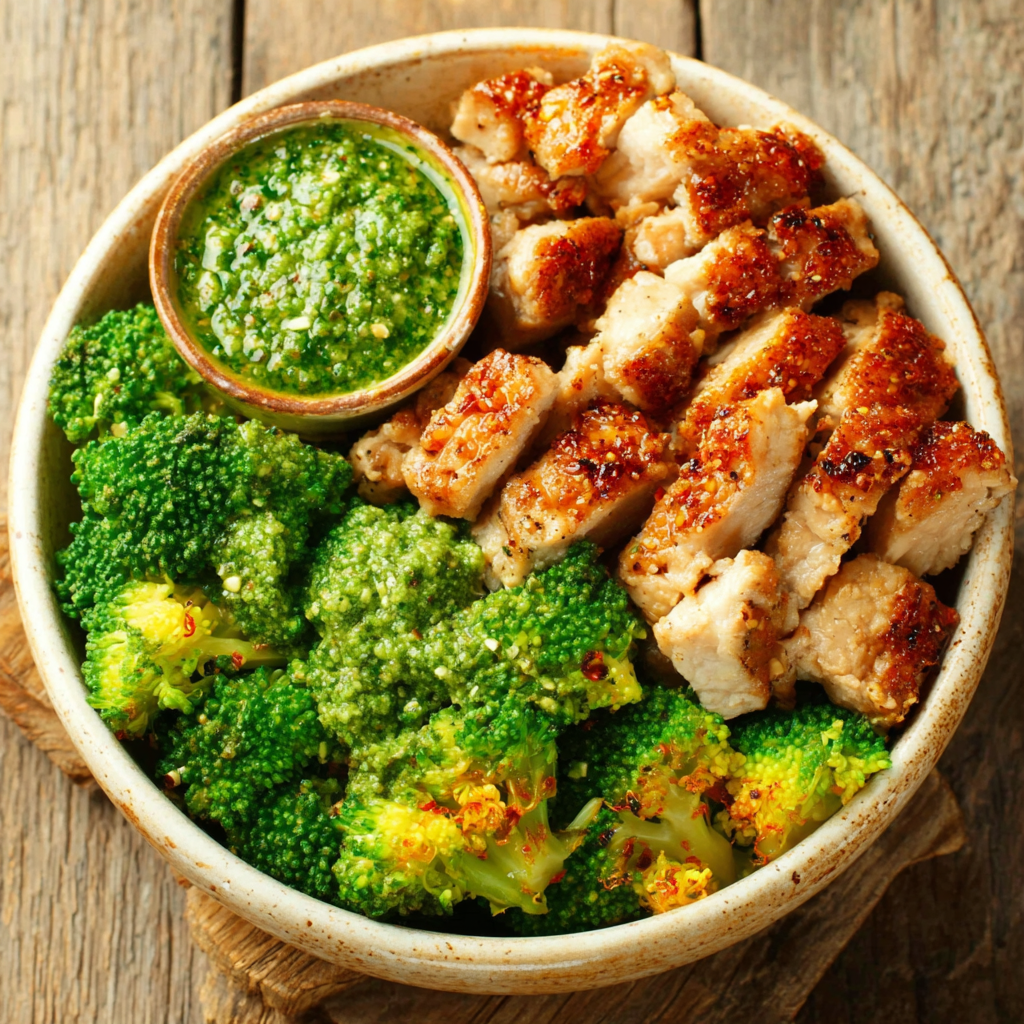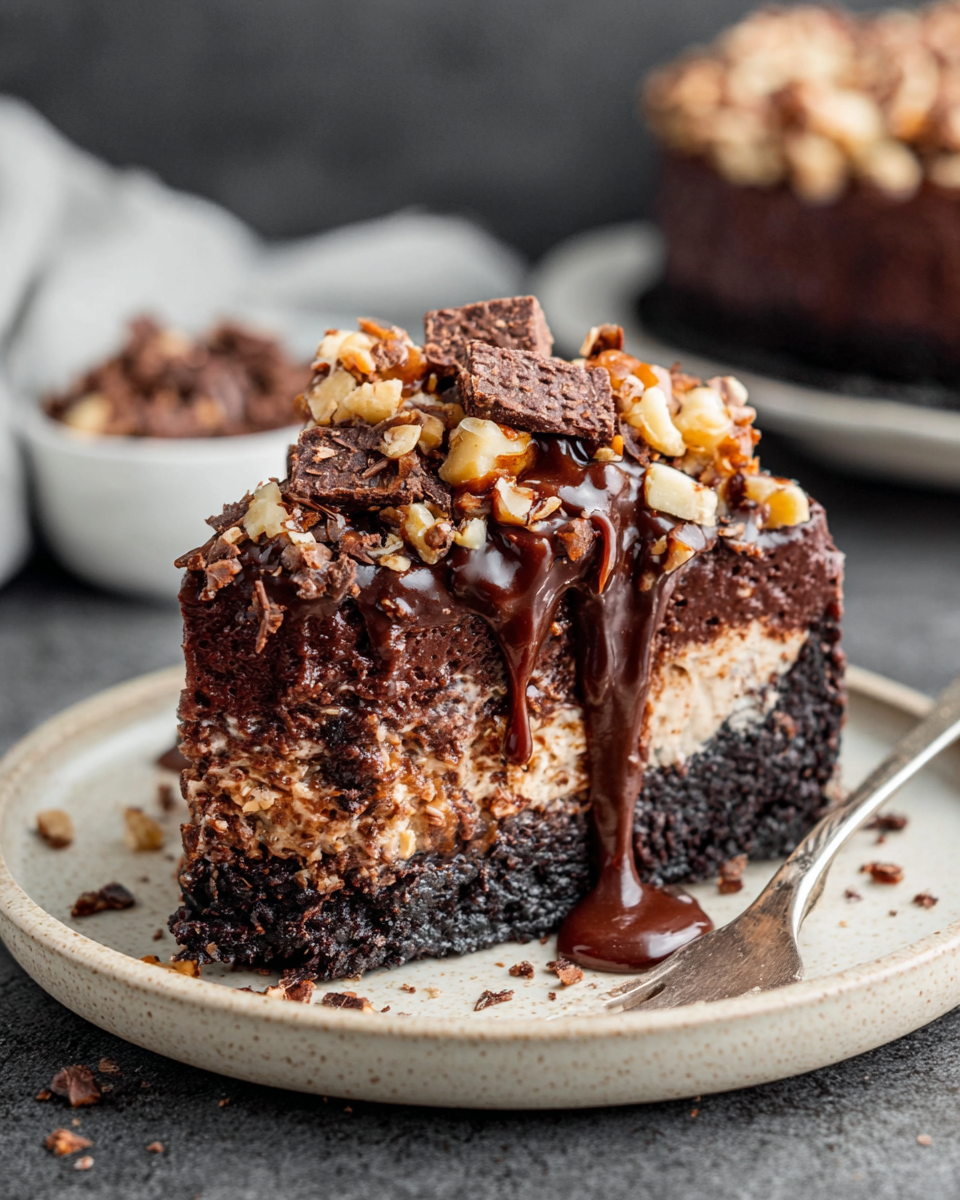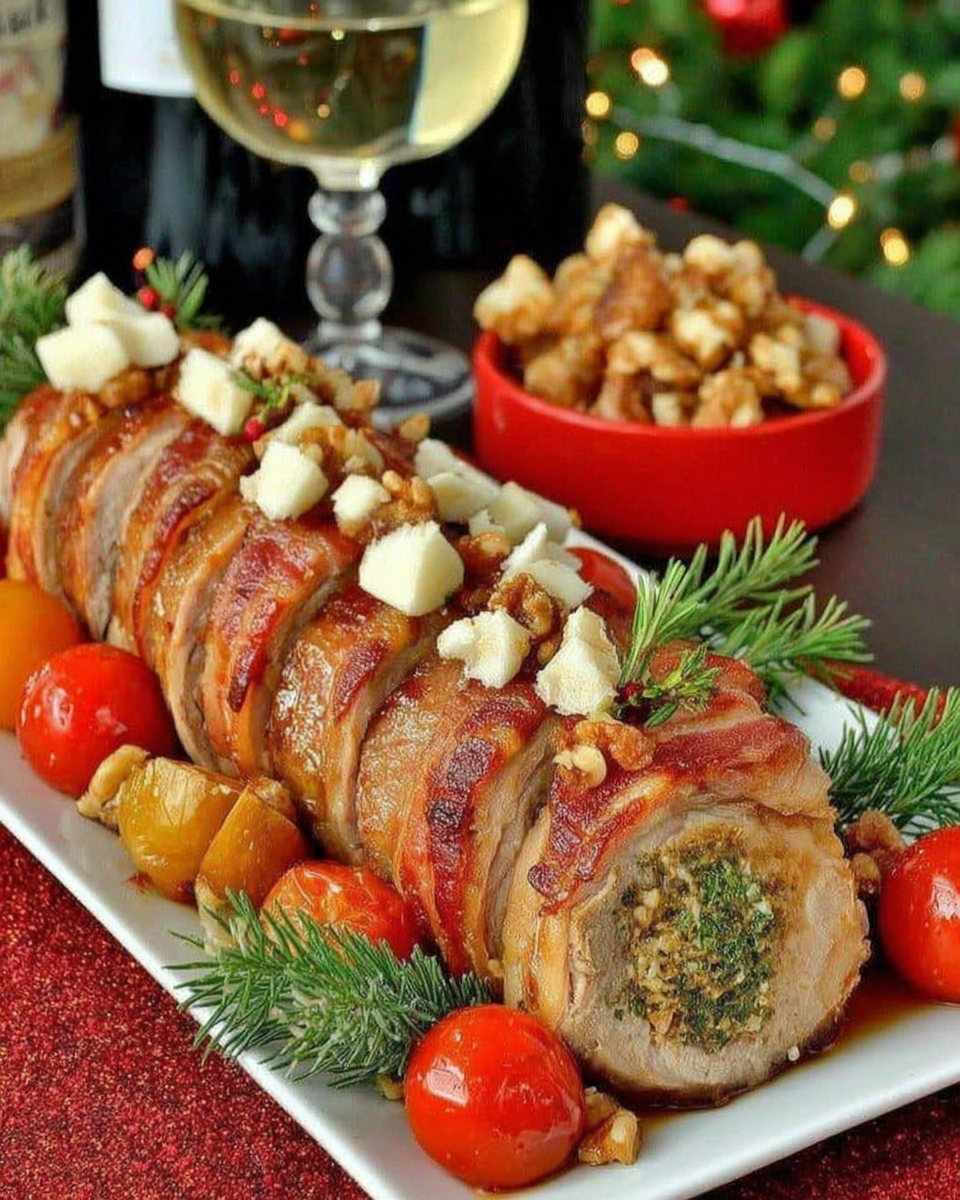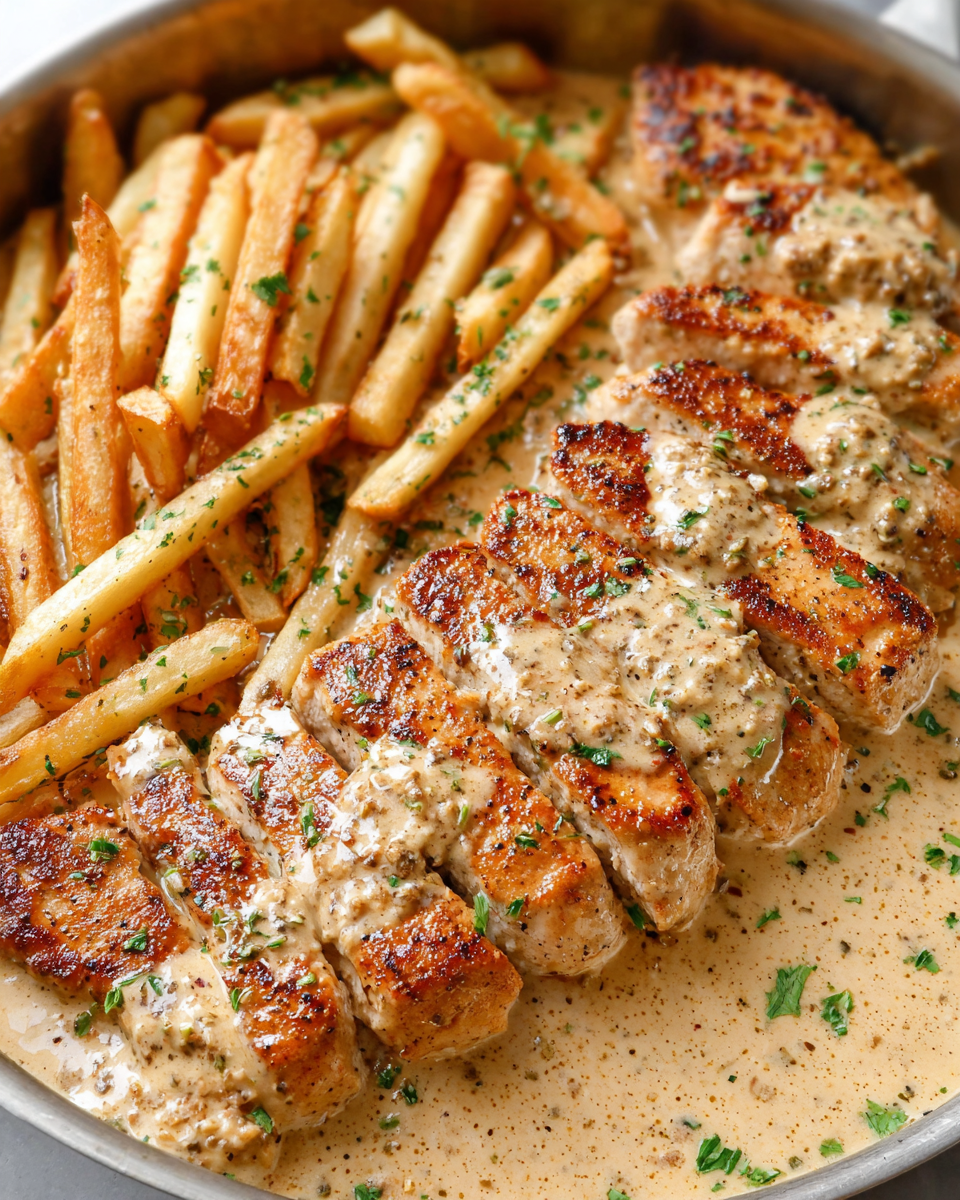Introduction
If you're in search of a vibrant, delicious meal that comes together in no time, look no further than these easy chicken pesto bowls with roasted broccoli. This dish balances the savory flavors of chicken, the aromatic freshness of pesto, and the satisfying crunch of perfectly roasted broccoli to create a harmonious dinner option.
Perfect for busy weeknights or even casual entertaining, each bowl offers a satisfying combination of protein, veggies, and delightful herbs. Plus, it's a great way to utilize any leftover pesto you may have. The best part? It can be on your table in under an hour!
Ingredients
- 2 boneless, skinless chicken breasts
The chicken breasts serve as the protein base for your bowls. They can be seasoned and cooked easily, absorbing the pesto flavors beautifully while remaining juicy. - 1 cup pesto sauce
Pesto sauce brings the dish to life with its fresh basil, garlic, and pine nut flavor profile. It coats the chicken to infuse every bite with its vibrant essence and unites all the ingredients in the bowl. - 2 cups broccoli florets
Broccoli not only adds a nutritional boost with its vitamins and minerals, but roasting it also enhances its natural sweetness and creates a delightful texture contrast against the tender chicken. - 1 tablespoon olive oil
The olive oil is essential for roasting the broccoli, helping it develop a golden crust while adding a rich flavor. It also prevents the broccoli from sticking to the baking sheet. - Salt and pepper to taste
Seasoning with salt and pepper enhances all the natural flavors of the chicken and vegetables, ensuring that the dish is balanced and well-rounded. - Cooked rice or quinoa (for serving)
Serving the chicken and broccoli over a bed of rice or quinoa adds heartiness to the meal, making it filling and satisfying, while also providing a neutral base that complements the vibrant pesto.
Directions & Preparation
Step 1: Preheat the oven to 400°F (200°C).
Preheating your oven is crucial for ensuring that the broccoli roasts evenly and achieves that desirable crispy texture. Starting with a hot oven helps to lock in flavors and moisture, enhancing the overall dish.
Step 2: Prepare the chicken breasts by seasoning them with salt and pepper.
Seasoning the chicken is key to developing flavor throughout the cooking process. A simple rub of salt and pepper can transform the chicken, ensuring that each bite is well-seasoned. It also forms a nice crust when seared.
Step 3: In a pan over medium heat, add a drizzle of olive oil and sear the chicken breasts for 3-4 minutes on each side.
Searing the chicken briefly enhances its flavor through browning while also helping to keep juices locked inside. This step is vital for maximizing flavor and achieving that perfect golden color before baking.
Step 4: Meanwhile, toss the broccoli florets in a bowl with olive oil, salt, and pepper.
Coating the broccoli in olive oil ensures that it roasts evenly and develops a charred exterior. This step adds a layer of flavor, allowing the olive oil to penetrate the broccoli, enhancing its natural sweetness.
Step 5: Transfer the seared chicken to the baking dish and add the tossed broccoli around it.
Combining the chicken and broccoli in one dish allows the flavors to meld during baking. It also simplifies cleanup, making the meal prep more efficient without sacrificing taste.
Step 6: Bake in the oven for 15-20 minutes, until the chicken is cooked through and broccoli is tender.
Baking the chicken and broccoli together ensures that both elements reach the perfect doneness. Use a meat thermometer to check that the chicken reaches an internal temperature of 165°F (74°C), guaranteeing it is safe to eat.
Step 7: Once cooked, remove from the oven and let the chicken rest for a few minutes before slicing.
Resting the chicken allows the juices to redistribute, making it more succulent. This step prevents dryness, ensuring every slice is juicy and flavorful while allowing time for the flavors to settle.
Step 8: Slice the chicken, then mix with pesto sauce, and serve over a bed of rice or quinoa with the roasted broccoli on the side.
Mixing the sliced chicken with pesto enhances the dish's flavor significantly, allowing every piece of chicken to be enveloped in flavor. Serving over a grain gives it substance, making it a complete and nourishing meal.

The Versatility of Pesto in Home Cooking
Pesto is an incredibly versatile ingredient that can elevate countless dishes beyond pasta. This recipe showcases how pesto acts as a marinating agent for chicken, infusing flavor seamlessly. Beyond this bowl, consider using pesto in salads, on sandwiches, or as a dipping sauce to add depth and vibrancy to everyday meals.
Choosing the Right Vegetables
While broccoli is the star here, feel free to adjust the vegetables based on your preferences or seasonal offerings. Asparagus, zucchini, or bell peppers would also work beautifully roasted alongside the chicken, providing a colorful and nutrient-rich dish. Experimenting with different veggies can add new flavors, textures, and visual appeal to your chicken pesto bowl.
Making It a Meal Prep Favorite
This chicken pesto bowl not only delivers fantastic flavor but also fits perfectly into meal prep routines. Preparing a large batch allows you to store servings in the fridge for quick, healthy lunches throughout the week. Ensuring your bases—like grains and proteins—are prepped ahead of time makes this dish a convenient option for busy lives.
FAQs
What can I do if the broccoli isn't crispy enough?
If the broccoli isn't crispy after roasting, try increasing the oven temperature slightly or roasting it for a few minutes longer. Ensure that the florets are evenly spaced on the baking sheet for optimal roasting.
Can I use leftover chicken for this recipe?
Absolutely! Leftover rotisserie chicken is a fantastic shortcut for this meal. Simply heat it through with pesto and serve over your base with roasted broccoli for a quick dinner.
What if I want a creamier texture in the bowl?
For a creamier bowl, consider adding a dollop of ricotta or a drizzle of cream to the chicken and pesto mixture. This will enhance the richness and create a more indulgent experience.
How can I add more flavor to my chicken?
If you want to enhance the chicken’s flavor, let it marinate in the pesto for at least 30 minutes before cooking. This will deepen the flavors and provide a succulent base for your bowls.
Can I make this dish vegetarian?
Yes, substitute the chicken with chickpeas or marinated tofu. They will absorb the pesto's flavors and provide a satisfying protein element while keeping the dish vegetarian.
What if my chicken appears overcooked?
If the chicken appears dry, be sure to check the oven temperature accuracy. In the future, consider using a meat thermometer to avoid any overcooking, ensuring that chicken hits the perfect juiciness level.
Conclusion
This easy chicken pesto bowl with roasted broccoli is sure to become a weeknight staple in your home. Its vibrant flavors, quick preparation time, and flexibility make it an ideal choice for any busy cook.
So the next time you’re looking for a light yet satisfying meal, remember this recipe. It’s bound to please even the pickiest of eaters while adding a burst of freshness to your dinner table.
Recipe Card
Comforting Butternut Squash Pasta with Sausage and Spinach
Ingredients
- 12 oz pasta penne or fettuccine
- 1 lb Italian sausage casings removed
- 2 cups butternut squash peeled and cubed
- 3 cups fresh spinach
- 1 small onion diced
- 3 cloves garlic minced
- 1/2 cup heavy cream
- 1/2 teaspoon nutmeg
- Salt and pepper to taste
- Olive oil for sautéing
Instructions
- Cook the pasta according to package instructions.
- Sauté the onion and garlic in olive oil.
- Add the sausage to the skillet and cook until browned.
- Incorporate the butternut squash.
- Pour in the heavy cream and season.
- Add the spinach and cooked pasta.
- Serve hot and enjoy.
Notes
Additional serving suggestions: pair with a crisp salad, garlic bread, or roasted seasonal vegetables for balance.
For make-ahead, prep components separately and assemble just before heating to preserve texture.
Taste and adjust with acid (lemon/vinegar) and salt right at the end to wake up flavors.








